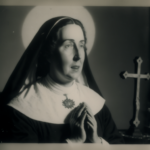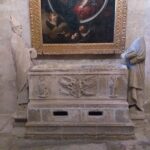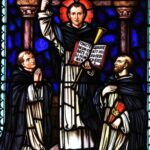
St. John of Damascus
St. John of Damascus
When he lived: St. John of Damascus, also known as John Damascene, lived from around 676 AD to 749 AD.
Where he lived: St. John of Damascus was born and spent most of his life in Damascus, which is now the capital of Syria. At that time, Damascus was a vital center of trade, culture, and learning in the Byzantine Empire.
Notable world events during the time of his life:
- Islamic Expansion: During St. John’s lifetime, the Islamic Caliphate was expanding rapidly. The Battle of Tours in 732 AD marked a significant event when the Franks, under the leadership of Charles Martel, halted the Muslim expansion into Europe.
- Iconoclasm Controversy: St. John of Damascus lived during the height of the Iconoclasm Controversy in the Byzantine Empire. He was a staunch defender of the veneration of icons and wrote extensively in support of their use.
- Rise of the Carolingian Empire: St. John’s era saw the establishment of the Carolingian Empire under Charlemagne, who was crowned Holy Roman Emperor in 800 AD.
- Abbasid Caliphate and the House of Wisdom: The Abbasid Caliphate, centered in Baghdad, flourished during St. John’s time. This period witnessed significant advancements in science, philosophy, and culture.
- Umayyad and Abbasid Conflict: The ongoing conflict between the Umayyad and Abbasid Caliphates had repercussions across the Islamic world.
His patronage: St. John of Damascus is known as the patron saint of scholars, theologians, and writers. His intellectual contributions and unwavering faith have made him an inspirational figure for those dedicated to the pursuit of knowledge and the exploration of spirituality.
Early Life and Education
John was born in Damascus, Syria, in the late 7th century. His father, Sergius, was a high-ranking government official, and his mother, Maria, was a devout Christian. From a young age, John was well-educated and fluent in both Greek and Arabic. He studied at the monastery of St. Sabas near Jerusalem, where he became a monk and devoted himself to a life of prayer and study.
The Iconoclastic Controversy
In the 8th century, a movement known as Iconoclasm swept through the Byzantine Empire. Iconoclasts believed that the use of icons, or religious images, was a form of idolatry and should be abolished. This belief was met with strong opposition from many Christians, who saw icons as a way to honor and venerate the saints.
John of Damascus was one of the most vocal opponents of Iconoclasm. He wrote several treatises defending the use of icons, including “Three Treatises on the Divine Images” and “On the Divine Images: Against Those Who Attack Them.” In these works, John argued that icons were not idols but rather a way to honor the saints and venerate Christ. He also argued that the use of icons was rooted in the Christian tradition and had been endorsed by previous Church fathers.
John’s arguments were influential in the eventual defeat of Iconoclasm. In 787, the Second Council of Nicaea issued a decree affirming the use of icons in the Church, a decision that is known as the Triumph of Orthodoxy.
Other Contributions
In addition to his work on icons, John of Damascus was also a prolific writer and theologian. He wrote extensively on a wide range of topics, including philosophy, theology, and church history. He is perhaps best known for his work “The Fountain of Knowledge,” which is a summary of the entirety of Christian doctrine. This work was widely read and was considered a seminal text in the field of theology.
John was also a hymnographer, and he is credited with writing some of the most famous hymns in the Eastern Christian tradition. One of his most famous hymns is the “Hymn of the Pearl,” which is sung during the Feast of the Annunciation.
Legacy
John of Damascus was one of the most important figures in the history of Eastern Christianity. His defense of icons during the Iconoclastic Controversy helped to preserve the use of icons in the Church, and his writings on theology and philosophy continue to be studied and admired today. He was declared a saint by the Orthodox Church, and his feast day is celebrated on December 4th.
In conclusion, Saint John of Damascus was a remarkable figure who made significant contributions to the fields of theology, philosophy, and hymnography. His defense of icons during the Iconoclastic Controversy was instrumental in preserving the use of icons in the Church, and his writings continue to be studied and revered to this day.
Prayer to St. John
Yes, there is a prayer to Saint John of Damascus. The following is a traditional prayer for him:
O Holy Father John of Damascus,
Who, in defense of the holy icons,
Did suffer banishment for the love of Christ,
Intercede with Him to grant us grace.
To keep His commandments with all our hearts,
That we may be delivered from the snares of the enemy.
And win the crown of victory in the Kingdom of Heaven.
Amen.
Five Facts
- Saint John of Damascus was born in Damascus, Syria, in the late 7th century.
- He was a monk at the monastery of St. Sabas near Jerusalem and was well-educated in both Greek and Arabic.
- John was a vocal opponent of Iconoclasm and wrote several treatises defending the use of icons in the Church.
- He was a prolific writer and theologian and is known for his work “The Fount of Knowledge,” a summary of Christian doctrine.
- John was declared a saint by the Orthodox Church, and his feast day is celebrated on December 4th.



